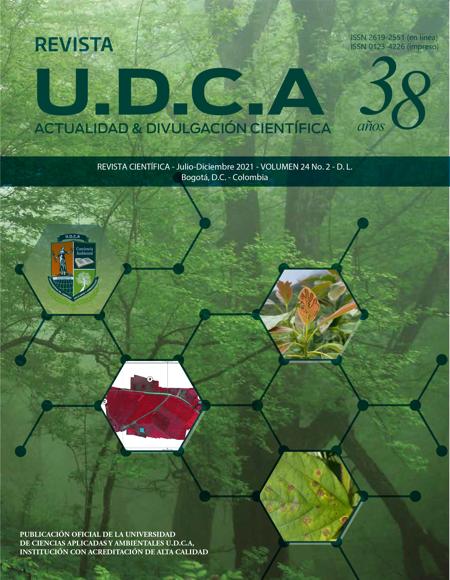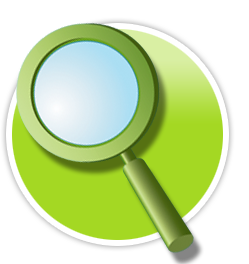Aplicación de redes neuronales convolucionales para la detección del tizón tardío Phytophthora infestans en papa Solanum tuberosum
Application of convolutional neural networks for detection of the late blight Phytophthora infestans in potato Solanum tuberosum
Contenido principal del artículo
Resumen
La presencia del tizón tardío o gota en el cultivo de papa afecta directamente el crecimiento de la planta y el desarrollo del tubérculo, por ello, es importante la detección temprana de la enfermedad. Actualmente, la aplicación de redes neuronales convolucionales es una oportunidad orientada a la identificación de patrones en la agricultura de precisión, incluyendo el estudio del tizón tardío, en el cultivo de papa. Este estudio describe un modelo de aprendizaje profundo capaz de reconocer el tizón tardío en el cultivo de papa, por medio de la clasificación de imágenes de las hojas. Se utilizó, en la aplicación de este modelo, el conjunto de datos aumentado de PlantVillage, para entrenamiento. El modelo propuesto ha sido evaluado a partir de métricas de rendimiento, como precisión, sensibilidad, puntaje F1 y exactitud. Para verificar la efectividad del modelo en la identificación y la clasificación del tizón tardío y comparado en rendimiento con arquitecturas. como AlexNet, ZFNet, VGG16 y VGG19. Los resultados experimentales obtenidos con el conjunto de datos seleccionado mostraron que el modelo propuesto alcanza una exactitud del 90 % y un puntaje F1, del 91 %. Por lo anterior, se concluye que el modelo propuesto es una herramienta útil para los agricultores en la identificación del tizón tardío y escalable a plataformas móviles, por la cantidad de parámetros que lo comprenden.
Palabras clave:
Descargas
Datos de publicación
Perfil evaluadores/as N/D
Declaraciones de autoría
- Sociedad académica
- Universidad de Ciencias Aplicadas UDCA
- Editorial
- Universidad de Ciencias Aplicadas y Ambientales U.D.C.A
Detalles del artículo
Referencias (VER)
ARNAL BARBEDO, J.G. 2018. Impact of dataset size and variety on the effectiveness of deep learning and transfer learning for plant disease classification. Computers and Electronics in Agriculture. 153:46-53.
https://doi.org/10.1016/j.compag.2018.08.013
ATILA, U.; UCAR, M.; AKYOL, K.; UCAR, E. 2021. Plant leaf disease classification using efficientNet deep learning model. Ecological Informatics. 61(2021):101182.
https://doi.org/10.1016/j.ecoinf.2020.101182
BETANCOURTH G., C.; PORTILLA B., E.; SALAS P., H. 2008. Evaluación de la reacción de nueve genotipos de papa (Solanum tuberosum Subsp. Andigena) al ataque de Phytophthora Infestans (Mont) de Bary. Agronomía Colombiana (Colombia). 26(3):411-116.
CHEN, J.; WAN, Z.; ZHANG, J.; LI, W.; CHEN, Y.; LI, Y.; DUAN, Y. 2021. Medical image segmentation and reconstruction of prostate tumor based on 3D AlexNet. Computer Methods and Programs in Biomedicine. 200:105878.
https://doi.org/10.1016/j.cmpb.2020.105878
DEVARAJ, A.; KARUNYA, R.; JAAHNAVI, S.; INDIRA, K. 2019. Identification of plant disease using image processing technique. Proceedings of the 2019 IEEE International Conference on Communication and Signal Processing, ICCSP. p.749-753.
https://doi.org/10.1109/ICCSP.2019.8698056
FERENTINOS, K.P. 2018. Deep learning models for plant disease detection and diagnosis. Computers and Electronics in Agriculture. 145(2018):311-318.
https://doi.org/10.1016/j.compag.2018.01.009
FU, L.; MAJEED, Y.; ZHANG, X.; KARKEE, M.; ZHANG, Q. 2020. Faster R–CNN–based apple detection in dense-foliage fruiting-wall trees using RGB and depth features for robotic harvesting. Biosystems Engineering. 197:245-256.
https://doi.org/10.1016/j.biosystemseng.2020.07.007
GEETHARAMANI, G.; ARUN PANDIAN, J. 2019. Identification of plant leaf diseases using a nine-layer deep convolutional neural network. Computers and Electrical Engineering. 76(2019):323-338.
https://doi.org/10.1016/j.compeleceng.2019.04.011
GU, J.; WANG, Z.; KUEN, J.; MA, L.; SHAHROUDY, A.; SHUAI, B.; LIU, T.; WANG, X.; WANG, G.; CAI, J.; CHEN, T. 2018. Recent advances in convolutional neural networks. Pattern Recognition. 77(2018):354-377.
https://doi.org/10.1016/j.patcog.2017.10.013
HUERTA-MORA, E.A.; GONZÁLEZ-HUITRÓN, V.; RODRÍGUEZ-RANGEL, H.; AMABILIS-SOSA, L.E. 2020. Detección de enfermedades foliares con arquitecturas de redes neuronales convolucionales. Revista Internacional De Desarrollo Regional Sustentable. 5(1):18–40.
HUGHES, D.P.; SALATHE, M. 2015. An open access repository of images on plant health to enable the development of mobile disease diagnostics. (Suiza) arXiv e-prints. Disponible desde Internet en:
http://arxiv.org/abs/1511.08060 (con acceso el 4/12/2021)
ISLAM, F; HOQ, M.N.; RAHMAN, C.M. 2019. Application of transfer learning to detect potato disease from leaf image. 2019 IEEE International Conference on Robotics, Automation, Artificial-Intelligence and Internet-of-Things (RAAICON). p.127-130.
https://doi.org/10.1109/RAAICON48939.2019.53
LECUN, Y.; BENGIO, Y.; HINTON, G. 2015. Deep learning. Nature (USA). 521(7553):436–444.
https://doi.org/10.1038/nature14539
LEE, T.Y.; YU, J.Y.; CHANG, Y.C.; YANG, J.M. 2020. Health Detection for Potato Leaf with Convolutional Neural Network. Indo - Taiwan 2nd International Conference on Computing, Analytics and Networks, Indo-Taiwan ICAN 2020 – Proceedings. p.289–293.
https://doi.org/10.1109/Indo-TaiwanICAN48429.2020.9181312
LOBO, G.P.; LARAWAY, J.; GADGIL, A.J. 2021. Identifying schools at high-risk for elevated lead in drinking water using only publicly available data. Science of The Total Environment. 803:150046.
https://doi.org/10.1016/j.scitotenv.2021.150046
MILITANTE, S.V.; GERARDO, B.D.; DIONISIO, N.V. 2019. Plant Leaf Detection and Disease Recognition Using Deep Learning. (Taiwan) 2019 IEEE Eurasia Conference on IOT, Communication and Engineering, ECICE 2019. p.579–582.
https://doi.org/10.1109/ECICE47484.2019.8942686
NEUPANE, D.; SEOK, J. 2020. Bearing fault detection and diagnosis using case western reserve university dataset with deep learning approaches: A review. IEEE Access. 8:93155-93178.
https://doi.org/10.1109/ACCESS.2020.2990528
PENG, Y.L.; LEE, W.P. 2021. Data selection to avoid overfitting for foreign exchange intraday trading with machine learning. Applied Soft Computing. 108:107461.
https://doi.org/10.1016/j.asoc.2021.107461
PÉREZ, W.; FORBES, G. 2011. Guía de identificación de plagas que afectan a la papa en la zona andina. Centro Internacional de la Papa -CIP. p.44.
PRASETYO, E.; SUCIATI, N.; FATICHAH, C. 2021. Multi-level residual network VGGNet for fish species classification. Journal of King Saud University - Computer and Information Sciences.
https://doi.org/10.1016/j.jksuci.2021.05.015
RAHMAN, C.R.; ARKO, P.S.; ALI, M.E.; IQBAL KHAN, M.A.; APON, S.H.; NOWRIN, F.; WASIF, A. 2020. Identification and recognition of rice diseases and pests using convolutional neural networks. Biosystems Engineering. 194(2020):112–120.
https://doi.org/10.1016/j.biosystemseng.2020.03.020
RANGARAJAN ARAVIND, K.; MAHESWARI, P.; RAJA, P.; SZCZEPAŃSKI, C. 2020. Crop disease classification using deep learning approach: an overview and a case study. In: Das, H.; Pradhan, C.; Dey, N. Deep Learning for Data Analytics. Academic Press. Polonia. p.173–195.
https://doi.org/10.1016/b978-0-12-819764-6.00010-7
SALEEM, T.J.; CHISHTI, M.A. 2021. Deep learning for the internet of things: Potential benefits and use-cases. Digital Communications and Networks.
https://doi.org/10.1016/j.dcan.2020.12.002
SHARMA, A.; JAIN, A.; GUPTA, P.; CHOWDARY, V. 2021. Machine Learning Applications for Precision Agriculture: A Comprehensive Review. IEEE Access. 9:4843–4873.
https://doi.org/10.1109/ACCESS.2020.3048415
SLADOJEVIC, S.; ARSENOVIC, M.; ANDERLA, A.; CULIBRK, D.; STEFANOVIC, D. 2016. Deep neural networks based recognition of plant diseases by leaf image classification. Computational Intelligence and Neuroscience. 2016:11
https://doi.org/10.1155/2016/3289801
TANG, Z.; YANG, J.; LI, Z.; QI, F. 2020. Grape disease image classification based on lightweight convolution neural networks and channelwise attention. Computers and Electronics in Agriculture. 178:105735.
https://doi.org/10.1016/j.compag.2020.105735
TOO, E.C.; YUJIAN, L.; NJUKI, S.; YINGCHUN, L. 2019. A comparative study of fine-tuning deep learning models for plant disease identification. Computers and Electronics in Agriculture. 161:272-279.
https://doi.org/10.1016/j.compag.2018.03.032
XIONG, Y.; LIANG, L.; WANG, L.; SHE, J.; WU, M. 2020. Identification of cash crop diseases using automatic image segmentation algorithm and deep learning with expanded dataset. Computers and Electronics in Agriculture. 177:105712
https://doi.org/10.1016/j.compag.2020.105712
YIN, W.; SUN, X.; DIAO, W.; ZHANG, Y.; GAO, X. 2021. Thermal power plant detection in remote sensing images with saliency enhanced feature representation. IEEE Access. 9:8249-8260.
https://doi.org/10.1109/ACCESS.2021.3049431
ZENG, Q.; MA, X.; CHENG, B.; ZHOU, E.; PANG, W. 2020. GANS-based data augmentation for citrus disease severity detection using deep learning. IEEE Access. 8:172882-172891.
https://doi.org/10.1109/ACCESS.2020.3025196
ZHANG, Z.; GAO, W.; ZHANG, F.; HUANG, Y.; DAI, S.; FAN, F.; ZHAN, J.; DU, M.; YIN, S.; XIONG, L.; DU, J.; CHENG, Y.; ZHOU, X.; REN, R.; WANG, L.; YE, H. 2019. Landscape of big medical data: a pragmatic survey on prioritized tasks. IEEE Access. 7:15590-15611.







